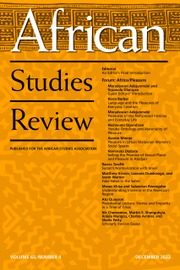Infrastructural Attachments offers a “long history of the austere infrastructural state in Kenya” (9) from the late nineteenth century to the middle of the 2010s. By analytically releasing austerity from its normative definition and chronology as a neoliberal 1970s policy regime, Park shows how it has been the foundational logic and approach to Kenyan statecraft since the early days of colonial occupation. Through an excavation of austerity’s antecedents including “sound finance” and colonial “self-sufficiency,” Infrastructural Attachments charts the emergence of the corporate-state in Kenya through infrastructure and the corporations outsourced to build them.
Conceptually rich, Infrastructural Attachments offers three key interventions that invite new histories of infrastructure, African expertise, postcolonial statecraft, and contemporary capitalism. First, Park urges a reconsideration of austerity not as fiscal retrenchment or state retreat, but as a mode of governance in which sovereignty is divisible, authority delegated, and infrastructural expansion outsourced. Second, rather than center grand infrastructural plans, Park introduces the concept of infrastructural attachments, “the material and conceptual tethers that bind institutions and people to new networks, ideologies, markets, and forms of circulation and blockage that they engender” (9). Third, Park proposes infrastructural prosthetics and prosthetic work to describe the transformative, often undervalued, and racialized labor of making infrastructures “hang together” (12).
The book is organized into three sections: road-construction from the late nineteenth century to the interwar era (Chapters One and Two); radio broadcasting from the Second World War to the late colonial period (Chapters Three and Four); and telecommunications-cum-digital financial services from the late 1990s to the 2010s (Chapters Five and Six). Through this broad sweep, Park shows how colonial and postcolonial governments have outsourced state-like functions to chartered companies such as the Imperial British East Africa Corporation (IBEAC), and later to firms including Cable and Wireless Ltd., and Safaricom.
Park introduces “divisible sovereignty” in Chapter One, a mode of late nineteenth-century imperial rule in which both the Crown and the Sultanate of Zanzibar outsourced sovereign powers, including taxation, to the IBEAC. The second chapter then explores how the IBEAC and colonial state sought to conscript African communities into imperial regimes of labor and value through roadbuilding. Reliant on African topographical expertise and the prosthetic work of guides and traders, colonial actors nonetheless systematically undervalued this work while imposing coercive measures (taxation, company currency, forced labor) to attach people to the road and wage economy.
Building on these themes, in Chapter Three Park traces the colonial state’s outsourcing of radio broadcasting to Cable and Wireless Ltd., a corporation that prioritized white settler and South Asian audiences. Yet, broadcasting depended on African experts to work as technicians, translators, and cultural mediators. The tension between imperial efforts to “broadcast development” and African knowledge workers’ tactical appropriations of the medium under conditions of austerity is further explored in Chapter Four. Rising postwar discontent and anti-imperial movements including Mau Mau and the Egyptian Revolution saw reactionary colonial administrators reframe radio as an infrastructure of “containment and counterinsurgency” (123) and released Treasury funding for state-run broadcasting for the first time in Kenya’s history. Rather than contain unrest, Kenyans reconfigured radio as a public good and a site of contest for making claims on the settler colonial state.
Moving forward in time, in the final section Park argues that digital services giant Safaricom functions as a hybrid corporate-state, offering state-like services while remaining a profit-driven corporation accountable to multinational stakeholders rather than the Kenyan public. Chapter Five centers Safaricom’s 2008 IPO as a watershed moment in the reconfiguration of the Kenyan corporate-state. Foreign capitalists and Kenyan elites recast public assets as divisible, and Kenyans as shareholder-citizens and citizen-clients. The final chapter foregrounds the social and affective labor underpinning Safaricom’s success by offering a window into the life of Peninah, an M-Pesa agent. These agents are not mere “intermediaries,” but infrastructural prosthetics whose social knowledge, cultural discernment, and “para-ethnographic” work (158) fuel Safaricom’s network and product development.
Methodologically, Infrastructural Attachments is ambitious and textured. Park pursues a multi-scalar approach that weaves together archival, ethnographic, and oral historical research. Park’s writing, attentive to voice, reflects the core argument about multiplicity and the valuation of African expertise. The analysis is not only grounded in academic theory, but in Kenyan modes of critique. By engaging with Kenyan writers, bloggers, satirists, and public intellectuals, Park demonstrates that austerity and infrastructural unevenness have long been subjects of critical reflection and empirical analysis within Kenya.
By tracking infrastructural governance over 150 years, Park offers a genealogy of austerity and corporate-state formation that links the politics of divisibility in Kenya’s present to those of the nineteenth century. This approach is one of the book’s major strengths, yet it comes with some trade-offs. Like the shortwave radio travelling vast distances, the narrative sometimes moves quickly across time and space without pausing long enough in specific communities or places. Moments when we might more fully grasp the worlds of Kamba traders, Kikuyu forced laborers, or even Nairobi’s many other M-Pesa agents, pass quickly. This point notwithstanding, Infrastructural Attachments is essential reading for scholars of neoliberalism, infrastructure, labor, expertise, and colonial and postcolonial governance, and technology in Africa and far beyond.

